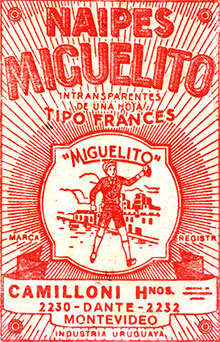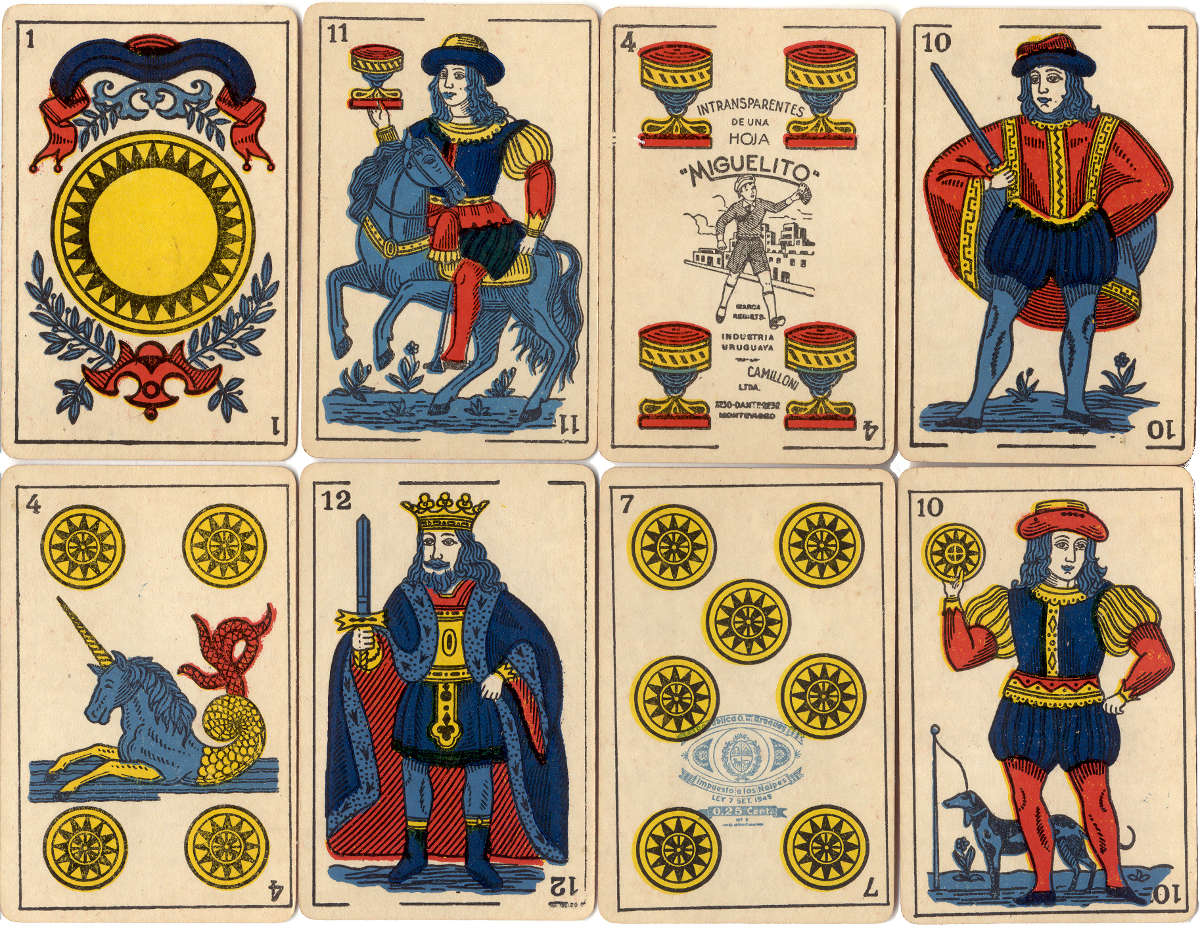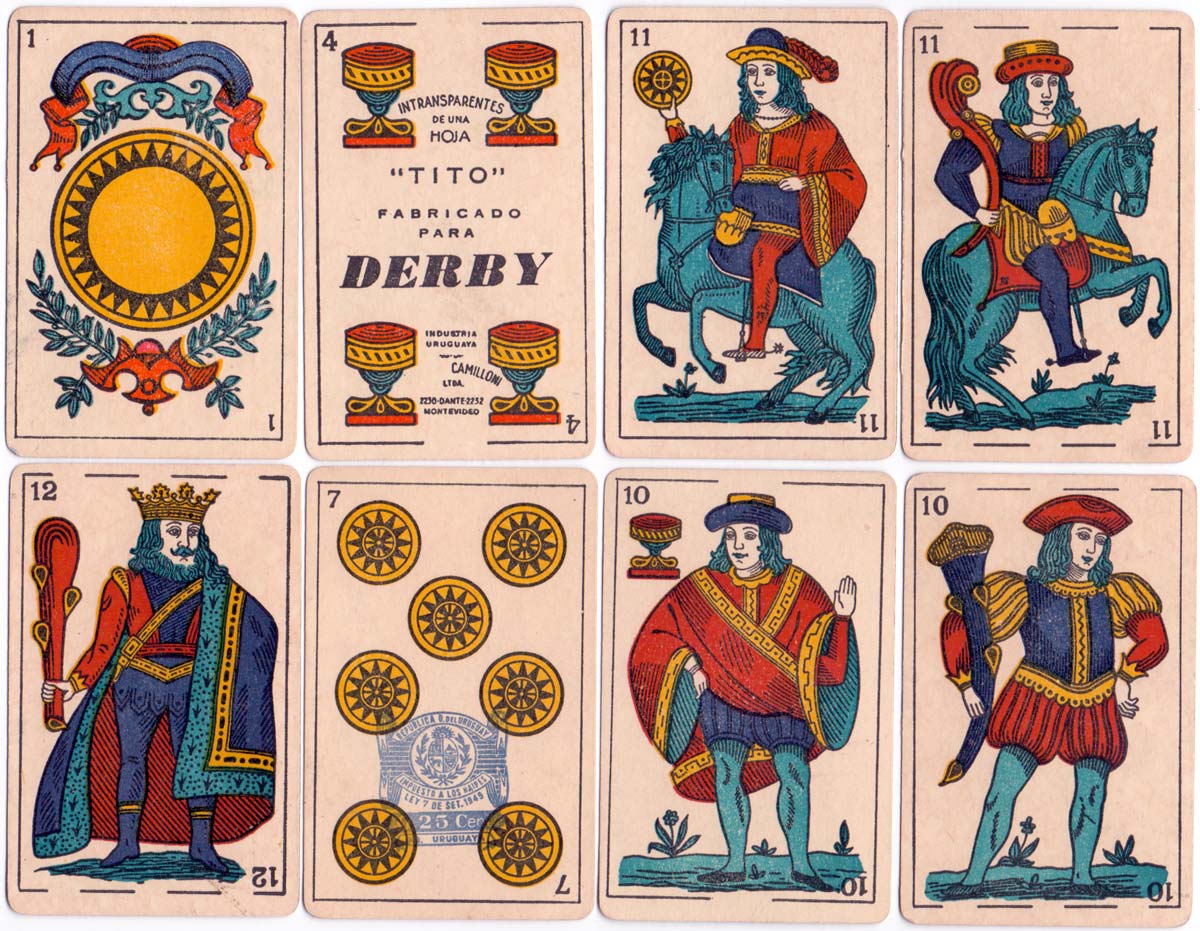Naipes ‘Miguelito’
The standard Spanish-suited 'Parisian' style (Tipo Frances) is based on models exported to South America by French manufacturers during the nineteenth century.

Naipes ‘Miguelito’ manufactured by Camilloni Ltda, Montevideo, c.1950
The box (shown right) and the four of cups show young Miguelito setting off to school at a brisk march. The manufacturer’s name given on the box is 'Camilloni Hnos’ wheras on the four of cups it is 'Camilloni Ltda’. The latter looks as though the first part of the name has been removed: the company had recently changed name from ‘Flaiban & Camilloni’ to ‘Camilloni Hnos’ and then again to ‘Camilloni Ltda’. The same cards were also produced with the name "Tito" on the four of cups.
The cards are of the standard Spanish-suited 'Parisian’ pattern (Tipo Francés) based on models exported to South America by French manufacturers during the nineteenth century, eg Alphonse Arnoult, B.P. Grimaud, etc. with a sea monster on the four of coins. The tethered hound on the jack of coins is another characteristic. The seven of coins has the blue 25 centésimo tax stamp which was applied to playing cards in Uruguay at this time (1949-60).

Above: Naipes ‘Miguelito’ manufactured by Camilloni Ltda, Montevideo, c.1950. 40 cards in box.
Naipes “Tito”

Above: Naipes ‘Tito’ manufactured for ‘Piedra Alta’ by Camilloni Ltda, Montevideo, 1950s. 40 cards in box, same Parisian Spanish pattern designs. It is a curious feature of this pattern that the king of cups has only one leg!

Above: Naipes ‘Tito’ manufactured for ‘Derby’ by Camilloni Ltda, Montevideo, 1950s. 40 cards in box.
Camilloni Hnos also produced Naipes ‘Tela de Araña’.

By Simon Wintle
Member since February 01, 1996
I am the founder of The World of Playing Cards (est. 1996), a website dedicated to the history, artistry and cultural significance of playing cards and tarot. Over the years I have researched various areas of the subject, acquired and traded collections and contributed as a committee member of the IPCS and graphics editor of The Playing-Card journal. Having lived in Chile, England, Wales, and now Spain, these experiences have shaped my work and passion for playing cards. Amongst my achievements is producing a limited-edition replica of a 17th-century English pack using woodblocks and stencils—a labour of love. Today, the World of Playing Cards is a global collaborative project, with my son Adam serving as the technical driving force behind its development. His innovative efforts have helped shape the site into the thriving hub it is today. You are warmly invited to become a contributor and share your enthusiasm.
Related Articles

Parisian Spanish pattern by Fossorier, Amar et Cie
‘Parisian’ Spanish pattern published by Fossorier, Amar et Cie (Paris), c.1902.

Parisian style Spanish deck by Grimaud
Parisian style Spanish deck by Grimaud for export to Uruguay.

Naipes ‘La Criolla’ by Anabella Corsi
Inspired by an archaic Spanish pattern formerly used in Spain during the 16th and 17th centuries.

Naipes ‘Charabon’
Naipes ‘Charabon’ - depicting the Gaucho as a national hero, Montevideo, 1983.

Naipes Artiguistas, 1816
Naipes Artiguistas published in Concepción del Uruguay, Entre Rios province (Argentina) in 1816, by ...

Playing Cards designed by Alvaros
Playing Cards designed by Alvaros, published by Eduardo Carrión, Montevideo, 2000

Club Nacional de Football, Uruguay
100th anniversary of the Club Nacional de Football, Uruguay, 1999.

Canasta
Canasta is a card game of the Rummy family which originated in Uruguay probably about 1947.

Copa de Oro 1980
Naipes “Copa de Oro 1980” manufactured by Compañía General de Fósforos Montevideana, 1980.

Naipes Victoria
Victoria playing cards manufactured in Uruguay by Compañía General de Fósforos Montevideana, c.1955....

Supermercados CHIP
Supermercados CHIP playing cards manufactured in Uruguay by Compañía General de Fósforos Montevidean...

Cía Gral de Fósforos
Compañía General de Fósforos Montevideana, founded in 1893.

Naipes Victoria Gaucho
Naipes Victoria Spanish-suited, gaucho-themed pack celebrating the culture and traditions of the gau...

Naipes ‘Baccarat’
An example of the typical version of the Spanish Catalan pattern which is widely used in South Ameri...

Las Cartas de Sara
Las Cartas de Sara (Yerba Mate) based on an idea by Diego Silva Pintos and illustrated by Hogue. Pro...

Chocolondo by Famosa
Chocolondo Waffle deck for Famosa.
Most Popular
Our top articles from the past 28 days

